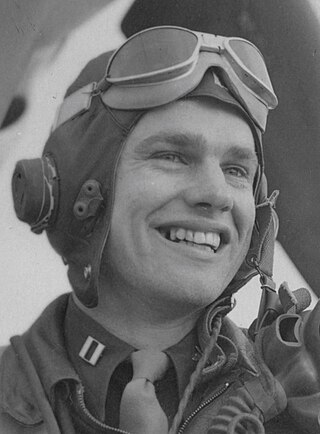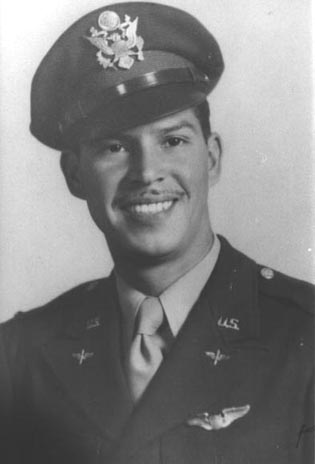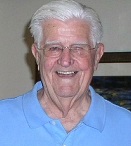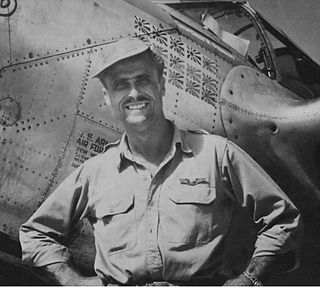Related Research Articles

USS Tulagi (CVE-72) was a Casablanca-class escort carrier of the United States Navy.

Clarence Emil "Bud" Anderson is a retired officer in the United States Air Force, a triple ace of World War II, and the highest scoring living American fighter ace. During the war he was the highest scoring flying ace in his P-51 Mustang squadron. Towards the end of Anderson's two combat tours in Europe in 1944 he was promoted to major at 22, a young age even for a highly effective officer in wartime. After the war Anderson became a well regarded fighter test pilot, and a fighter squadron and wing commander. He served his wing commander tour in combat in the Vietnam War. He retired as a full colonel in 1972, after which he worked in flight test management for McDonnell Douglas. A member of the National Aviation Hall of Fame, Anderson has remained a sought-after speaker at aviation and military events well into his 90s.

Norton Air Force Base (1942–1994) was a United States Air Force facility 2 miles (3.2 km) east of downtown San Bernardino in San Bernardino County, California.

Oscar Francis Perdomo was a United States Air Force officer and fighter pilot who was the last "ace in a day" for the United States in World War II.

The 108th Operations Group is a unit of the 108th Wing of the New Jersey Air National Guard, one of the many units stationed at the McGuire AFB entity of Joint Base McGuire-Dix-Lakehurst, New Jersey. If activated to federal service with the U.S. Air Force, the group is gained by Air Mobility Command.

Captain Henry Robinson Clay, Jr. was a World War I flying ace credited with eight confirmed aerial victories.

Jeremiah Joseph O'Keefe III was an American fighter ace, Democratic Party politician, insurance executive, and funeral director. As a Marine pilot in World War II he received the Navy Cross for five of the seven kills he recorded over Okinawa. After the war he entered politics, serving as a member of the Mississippi House of Representatives from 1960 to 1964 and as the mayor of Biloxi, Mississippi, from 1973 to 1981. The most prominent funeral homeowner in Biloxi, he won a $500 million jury award in a contractual dispute with the rival funeral home company Loewen Group, later settling for $175 million.

James Philo Hagerstrom was a fighter ace of both the United States Army Air Forces (USAAF) in World War II and the U.S. Air Force (USAF) in the Korean War. With a career total of 14.5 victories, he is one of seven American pilots to have achieved ace status in two different wars.

Robert Burdette Westbrook was a United States Army Air Forces lieutenant colonel and a World War II flying ace. Westbrook commanded the 44th Fighter Squadron, and became the leading fighter ace of the Thirteenth Air Force. He is also the ninth ranking fighter ace in the Pacific during World War II and also one of ten United States Army Air Forces pilots who became an ace in two different types of fighter aircraft.

Louis Edward "Lou" Curdes was an American flying ace of the United States Army Air Forces during World War II who held the unusual distinctions of scoring an official and intentional air-to-air kill against another American aircraft as well as shooting down at least one aircraft from each of the major Axis powers. Curdes was also a Prisoner of war escapee and spent about nine months in enemy held territory. He was awarded the Distinguished Flying Cross twice, a Purple Heart and the Prisoner of War Medal. He flew a Lockheed P-38 Lightning and a North American P-51 Mustang fighter aircraft with the latter having the nickname "Bad Angel."

The 1934 United Air Lines Boeing 247 crash was an accident involving a Boeing Air Transport-operated United Airlines scheduled flight of a Boeing 247, which crashed in bad weather shortly after departing Salt Lake City, Utah, on February 23, 1934, killing all eight on board. The cause was not immediately determined, but poor weather was considered a factor.
In 1934, all United States commercial air mail carrying contracts were cancelled due to controversy over how the contracts had been awarded. The United States Army Air Corps was charged with carrying air mail service, beginning 19 February 1934. Due in part to extremely bad weather, inadequate preparation of the mail pilots, and the inadequacies of pressing military aircraft into duties for which they were not designed, there ensued a series of accidents over the following three months, ending when commercial services were restored. In all, 66 major accidents, ten of them with fatalities, resulted in 13 crew deaths, creating an intense public furor. Only five of the 13 deaths actually occurred on flights carrying mail, but directly and indirectly the air mail operation caused accidental crash deaths in the Air Corps to rise by 15 percent to 54 in 1934, compared to 46 in 1933 and 47 in 1935.

William Douglas Dunham was an American flying ace in the 348th Fighter Group during World War II, scoring 16 aerial victories. He retired from the United States Air Force in 1970 at the rank of brigadier general.

Donald Jackson Strait was a major general who served as a career officer in the United States Air Force and was a flying ace with the 356th Fighter Group during World War II.
References
- ↑ "American Fighter Aces". www.americanfighteraces.org. Archived from the original on 2007-09-12.
- ↑ United Press, "Army Flier Bags Five Japs In Single Fight", The San Bernardino Daily Sun, San Bernardino, California, Monday 4 June 1945, Volume 51, page 1.
- ↑ United Press, "Army Flier Bags Five Japs In Single Fight", The San Bernardino Daily Sun, San Bernardino, California, Monday 4 June 1945, Volume 51, page 1.